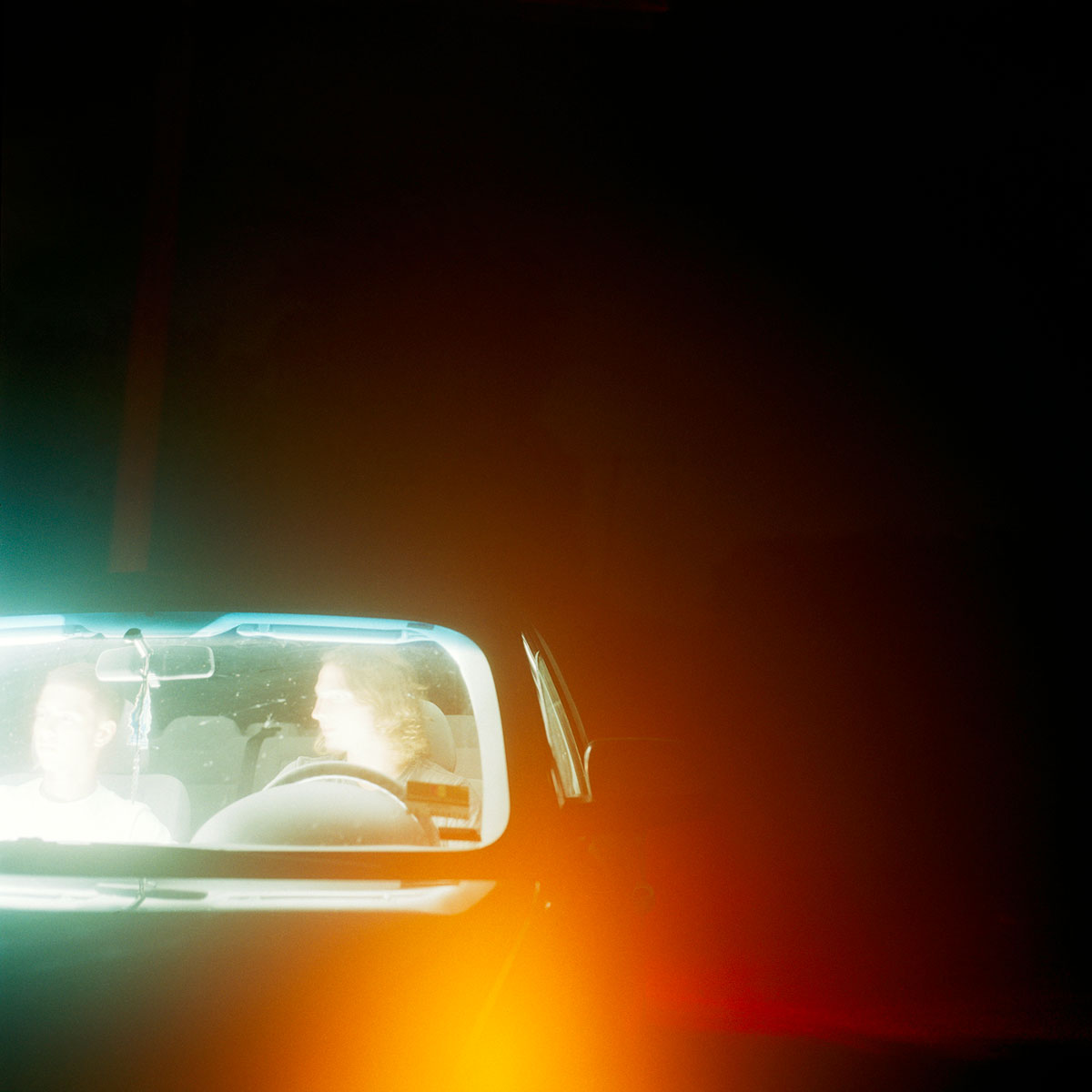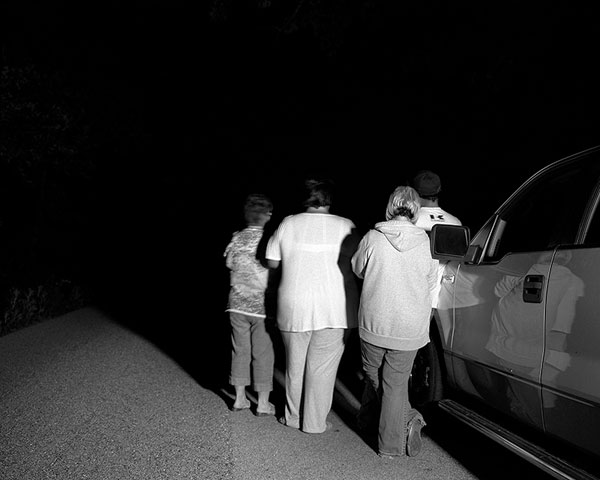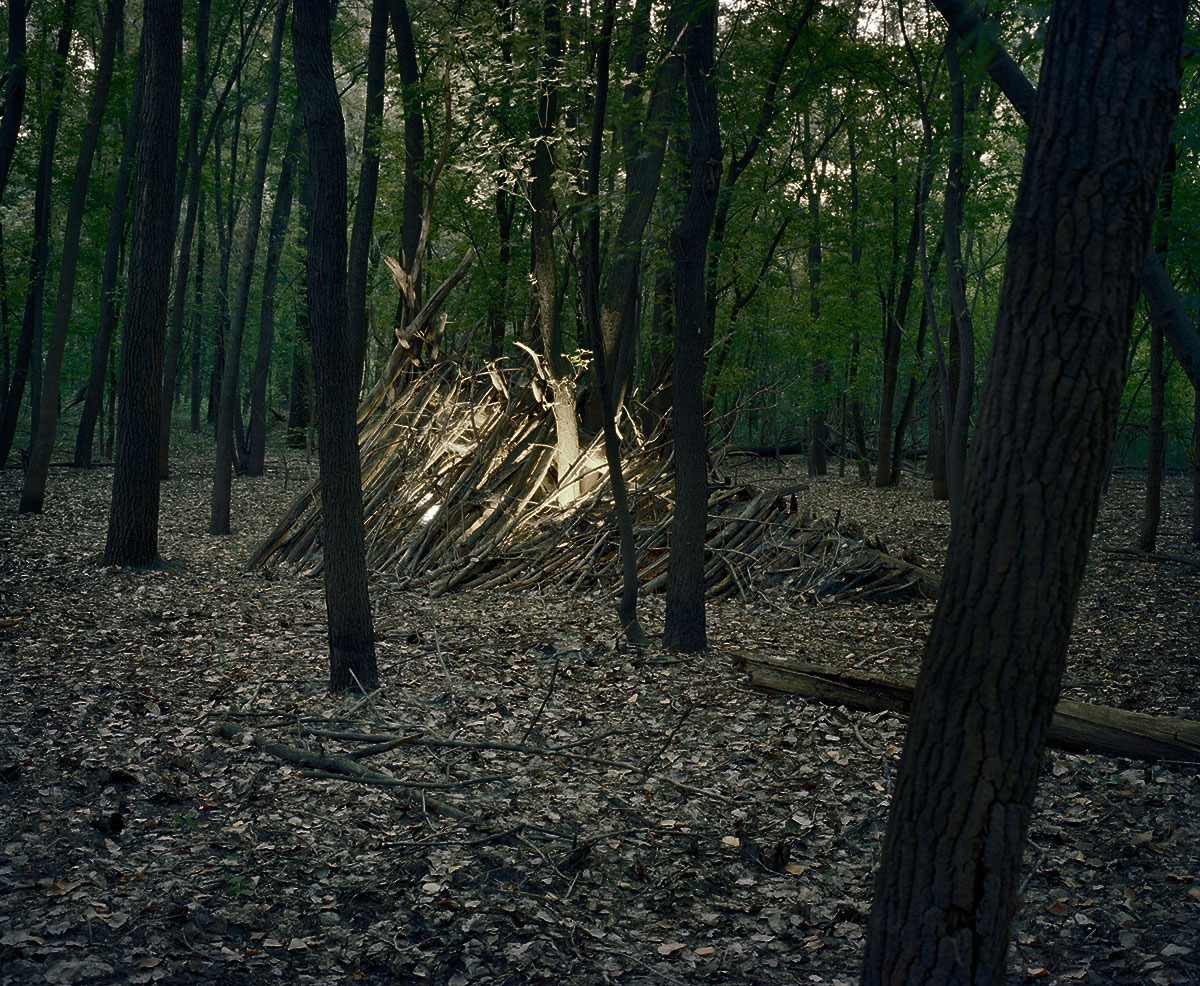

Dolezal, Shipley
Waiting for the Light
Archival Pigment Print
30 x 30in
2013
I: The Road and the Light
If you spend any time in the Ozark Hills you’re bound to hear tales of the Spook Light, a mysterious ball of light seen on chance nights bouncing down a lonely rural road. Growing up it was a recurring topic of conversation, one our parents told us and their parents told them. Many have tried and failed to discover its origins, including the United States Army Corps of Engineers in the 1950s. But they too came away baffled by the light’s frequent appearance.
As with most teenagers from this place our days were filled with long canoe trips on the river and restless nights spent on gravel roads, looking for a place to drink cheap beer. Whether we were wandering through the dark woods or exploring abandoned homes, the urge to search out spots that would give us a good fright was ingrained in our souls.
Driving down Spook Light Road on a summer night can give even the most skeptical Midwesterner an uneasy feeling. The road is covered in a canopy of dense overhanging trees, the ditches are deep grassy homes for copperhead snakes and the howl of coyotes can feel very close by. Through the trees you can see a few run-down family compounds and farmhouses. Many of the locals have told us it’s best not to step too far off the road in case a neighbor decides it’s a good night to practice their aim.
It’s a foreboding place, located in a region with a reputation for being wary of the outside world. Not surprisingly it’s mostly locals who seek out the light these days. They go in pursuit of the unexplainable, and to experience the frightening and strange place they live. They also go to have a story of their own to share, participating in a ritual of telling tales that has always been a characteristic of the Ozark people.


Dolezal, Shipley
Watchers
Archival Pigment Print
20 x 24in
2012


Shipley, Trees That Hold, Archival Pigment Print, 30 x 30in, 2012
Shipley, Believer, Archival Pigment Print, 30 x 30in, 2012
Shipley, From the Water, Archival Pigment Print, 30 x 30in, 2013
II: The Phosphorescent Man
Along Spook Light Road are the remains of a local relic once known as the Spook Light Museum. This shack in the woods, a museum only in the loosest of definitions, was a legendary hang out for generations of teens. It had a series of owners, all of whom adopted the name and identity of “Spooky,” making them impossible to distinguish in the stories locals still tell.
Whether we were wandering through the dark woods or exploring abandoned homes, the urge to search out spots that would give us a good fright was ingrained in our souls.
The museum’s main features were a pool table and jukebox. Plastered along the walls were countless newspaper and magazine clippings all relating to Spook Light lore and Spooky, the man behind the counter. Some of the stories paint Spooky as a guy just trying to make a living off of the phenomenon. One local told us, “He had a pipe welded out on his deck you could look through for a quarter and a basket full of spook rocks he drilled holes in and spray painted that he sold for a dollar. Boy, did he make a killin’!”
Other stories elevate the man to myth. He is sometimes referred to as the Phosphorescent Man, both as an ode to his knowledge of Spook Light history and for his own ethereal nature. “Some nights he would cram his little shack full of visitors for five dollars a head, cover himself in aluminum paint and dance naked under a black light,” proclaimed one resident.
Stranger yet are accounts of Spooky roaming the road fully nude, murmuring his song Come See the Spook Light Tonight and swaying to the sound of his own voice. “I swear some nights he was calling on the Devil himself,” revealed one Ozark man, referencing a common feeling that if the Devil was a real flesh and blood entity, seeing him out on the backwoods road at night wasn’t too far fetched.


Dolezal, Shipley
At Home
Archival Pigment Print
20 x 24in
2013
III: Those Who Remain
Down the winding road and a few miles past the remains of the Spook Light Museum you’ll find yourself in the ghost town of Hornet, MO. A few homes, a cemetery and a community house are all that stands along the only road through town. Those who remain have dispersed into the shade of the encroaching woods, camouflaged from the road and the curious few searching for the Spook Light. We set out to meet the enduring dwellers that inhabit the riverbanks and forests. What we found was an eclectic mixture of lonely souls hiding in the shadows and prospering characters living an independent life off the land. The stark distinction of people living in this region is a reminder of the symbolic significance the Spook Light holds for those here. It is a place overgrown with darkness yet strangely illuminated by its lively occupants.
One afternoon of wandering down the bank of the Spring River we came across an older man who remembered going out to see the Spook Light in the 1940s. “Back then there were stories of all kinds of lights happening out here, in all different locations. People stopped telling the stories and the lights decided to stop showing themselves.”
The stories of the past continue to hold a heavy significance for many people here. Nestled in the heart of the Bible belt the Ozarks is a place where the struggle between heaven and hell factor into everyday conversation, where tall tales are passed around campfires and Sunday morning prayers drift through the rolling hills. To dismiss the Spook Light as just another yarn conceived of by country folk, is to dismiss the unique culture that makes this region distinct – where the desire for myth can provide a reprieve from the realities of life, as long as people keep telling the tales.


Shipley, The Man From Ozark, Archival Pigment Print, 30 x 30in, 2013
Dolezal, A Small Grave, Archival Pigment Print, 20 x 24in, 2012
Shipley, Katrina’s Portrait, Archival Pigment Print, 30 x 30in, 2012